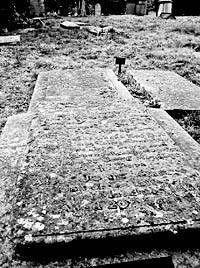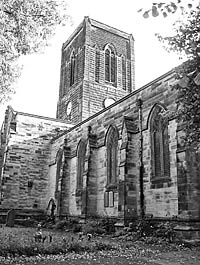Articles from the Thoroton Society Newsletter
George Green's Theorem
By George Murfet
During the autumn months of 2014, the Lakeside Pavilion exhibited documents recalling the life and times of George Green (1793-1841), the miller and mathematician who lived, if not in total obscurity, certainly without deserved celebrity status. In fact, it seems that without good fortune and the persistence of others, he might not have been recognised in his lifetime as the farsighted mathematician and physicist he was. But Green's Theorem is not the end of matters for there are, although perhaps not for the layman, Green's measure, Green's functions, Green's identities and Green's matrix.
Essentially, young George Green was self-taught and even though his formal education was decidedly limited it must have been overwhelmingly thorough in that it stimulated him at such a receptive, if tender, age. When eight years old, he attended Goodacre's Academy on Upper Parliament Street for only four terms since by then he had learnt all the mathematics it could teach him. Thereafter, it is thought that the headmaster of the Free Grammar School, John Toplis, might well have benefitted this precocious talent by using his own translations of the works of the French mathematician, La Place; the notation not being common in England at that time. Furthermore, the Nottingham Subscription Library, still known as Bromley House and still on Angel Row, also provided assistance with its science literature together with the conversations and interests in such subjects by its members. When in 1828, he published An Essay on the Applications of Mathematical Analysis to the Theories of Electricity and Magnetism, 51 of the library's members subscribed for copies, then priced at seven shillings and sixpence each. It was only in later years that he attended the University of Cambridge.
In 1829, his father, also named George, died leaving his son financially well placed. Young George was then able to lease out the milling business and additionally live upon the rents from land in Sneinton and houses in Nottingham; Sneinton being a separate village when the mill had been originally bought. George spent the years from 1833 until 1839 at Cambridge and became a fellow of Caius College, thinking of himself as having permanently left the roots of his upbringing. Also left behind were his children and the mother of his children. However, when confronted by failing health, George returned to Sneinton rightly forecasting that he would die there; he did so, on the 31st May 1841 at 3 Notintine Place. When Clara, George's youngest daughter, finally became heir to her father's considerable fortune it failed to bring lasting happiness, as also was the case for other family members, particularly his youngest son George: there being three generations named George Green.
A hundred years later, in May 1941, the area was bombed and in the years that followed Notintine Place was not a salubrious place to live. Fortunately, the bombing was close to the birthplace of the founder of the Salvation Army and so the whole area saw, in the late 20th century, redevelopment and a purpose-built complex there, dedicated to the memory of General William Booth.
It is accepted, and perhaps only natural, that George Green, the mathematician, would only ever be acknowledged by his peers, even if belatedly and solely by good fortune. What he eventually achieved in classical physics within the nineteenth century, and how it continues to influence other fields of study, owes more to chance, and heresay, than the scentific method. Within the twentieth century, whilst his windmill fell into decline through the use of steam driven roller mills Green's reputation grew among distinguished mathematicians and physicists and in 1993 tributes were paid to his memory at the University of Nottingham, Green's mill and St. Stephen's Church during the month of July; with a dedication of a plaque to him at Westminster Abbey on Friday, 16th of July, 1993.

George Green's graveslab (Photo George Murfet).
In contrast, the family grave, in the churchyard of St. Stephen's, is most disappointing with a mere slip of paper, pinned to a stave, indicating directions. Horizontal in construction, the grave's extremely large surface area is intended to include the details of other family members to be added when deaths occurred. The surface is still exposed to all weathers, and erosion makes the wording more difficult to read than that on the headstones of other graves, that fortunately have been up-rooted and placed against the extensive church wall. Virtually all the graves originate from the 19th century and the vast majority are vertical with clearly cut wording by the stonemasons. It is a great pity that the Green family grave cannot be highlighted and become a feature of St. Stephen's.
When a child and visiting my grandfather during the war, I was aware of the dilapidated state of Green's Windmill, even before its 1947 destructive fire, since the houses at the top of Roberts Street, off Windmill Lane, each had a long (dig for victory) garden that almost reached the mill; my granddad having one such garden. Those gardens are now part of the grounds belonging to the windmill. There was always an alternative approach to the windmill via Belvoir Hill and an uncle, when not on overseas RAF wartime duties, would park his transporter there. During all those years, coupled with the proximity, it is surprising that no mention was ever made of a mill-working mathematician who caught the attention of William Thompson (Lord Kelvin), Julian Schwinger, Freeman Dyson and others up to the present day.

St. Stephen's Church. (Photo George Murfet).
St. Stephen's Church (nowadays, the parish of St. Stephen's with St. Matthias) was attended by generations of the Green family and much later by my own paternal forebears but my grandfather was born in the year that the youngest George Green died: there being no overlap and so no contact. The church, Anglo-Catholic in its churchmanship, is austere and imposing, and undoubtedly commands the attention of every passer-by. Situated in the midst of mature trees, the grounds are protected by a high, red-brick wall, on the main side of which runs Sneinton Road, a bus route leading to Colwick Woods. On the opposite side, Newark Street used to run down to the 1874 built, three-sided factory of I & R Morley, the hosiery manufacturers, but alas no longer.
D. M. Cannell's publication George Green, Mathematician and Physicist, the Background to his Life and Work, 1793-1841 is highly recommended if the literature available at Green's Windmill (working and processing flour) is insufficient. For those interested in George's domestic life and the pursuit of the fellowship, and imagining that never having been married, and yet fathering seven children, could be a 'good read', let me not spoil the ending.
< Previous